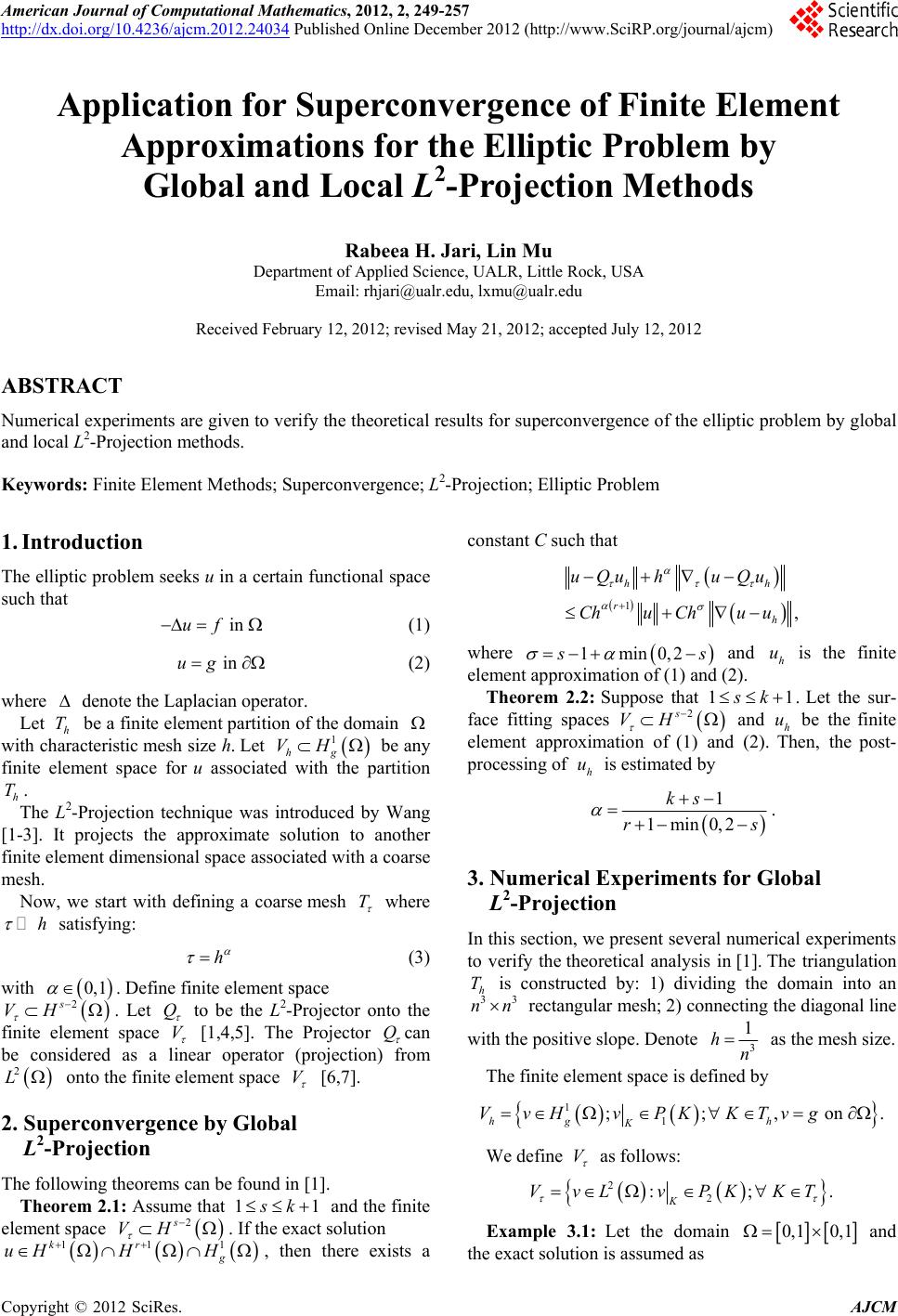 American Journal of Computational Mathematics, 2012, 2, 249-257 http://dx.doi.org/10.4236/ajcm.2012.24034 Published Online December 2012 (http://www.SciRP.org/journal/ajcm) Application for Superconvergence of Finite Element Approximations for the Elliptic Problem by Global and Local L2-Projection Methods Rabeea H. Jari, Lin Mu Department of Applied Science, UALR, Little Rock, USA Email: rhjari@ualr.edu, lxmu@ualr.edu Received February 12, 2012; revised May 21, 2012; accepted July 12, 2012 ABSTRACT Numerical experiments are given to verify the theoretical results for superconvergence of the elliptic problem by global and local L2-Projection methods. Keywords: Finite Element Methods; Superconvergence; L2-Projection; Elliptic Problem 1. Introduction The elliptic problem seeks u in a certain functional space such that in uf (1) in ug (2) where denote the Laplacian operator. Let h be a finite element partition of the domain T with characteristic mesh size h. Let be any finite element space for u associated with the partition . 1 hg VH h T The L2-Projection technique was introduced by Wang [1-3]. It projects the approximate solution to another finite element dimensional space associated with a coarse mesh. Now, we start with defining a coarse mesh T where h satisfying: h (3) with . Define finite element space . Let 0,1 2s VH Q to be the L2-Projector onto the finite element space V [1,4,5]. The Projector Q can be considered as a linear operator (projection) from onto the finite element space 2 L V [6,7]. 2. Superconvergence by Global L2-Projection The following theorems can be found in [1]. Theorem 2.1: Assume that 11 k and the finite element space . If the exact solution 2s VH 1 11krg H H uH , then there exists a constant C such that 1, hh rh uQu huQu ChuChu u where 1min0,2 s and is the finite element approximation of (1) and (2). h u Theorem 2.2: Suppose that 11 k u. Let the sur- face fitting spaces and h be the finite element approximation of (1) and (2). Then, the post- processing of is estimated by 2s VH h u 1 1min0,2 ks rs . 3. Numerical Experiments for Global L2-Projection In this section, we present several numerical experiments to verify the theoretical analysis in [1]. The triangulation is constructed by: 1) dividing the domain into an h T n 3 n 3 rectangular mesh; 2) connecting the diagonal line with the positive slope. Denote 3 1 hn as the mesh size. The finite element space is defined by 1 1 ;; , on hg h K VvH vPKKTvg. We define V as follows: 2 2 :; K VvLvPKKT . Example 3.1: Let the domain 0,1 0,1 and the exact solution is assumed as C opyright © 2012 SciRes. AJCM 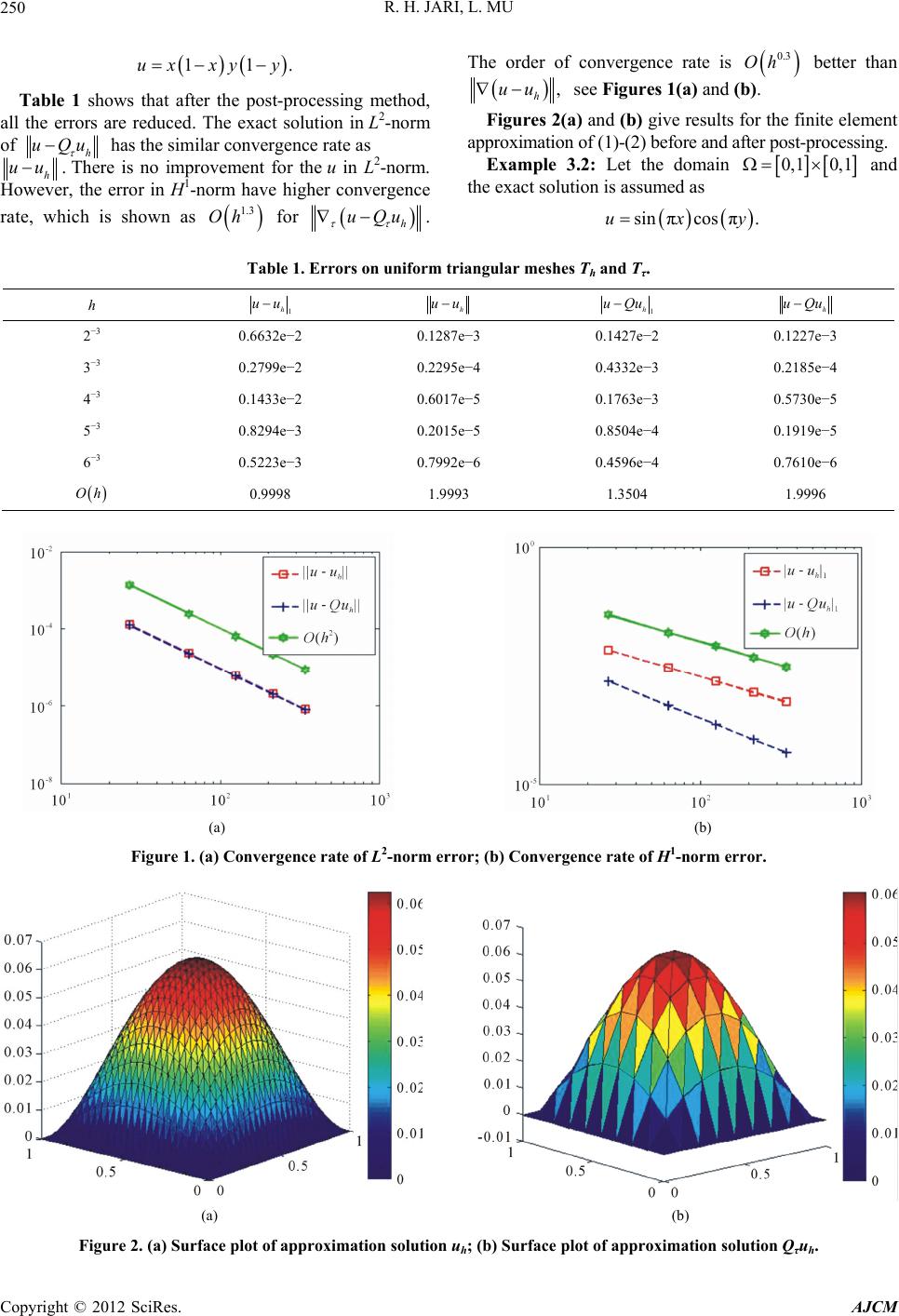 R. H. JARI, L. MU 250 11ux xyy . Table 1 shows that after the post-processing method, all the errors are reduced. The exact solution in L2-norm of h uQu has the similar convergence rate as h uu. There is no improvement for the u in L2-norm. However, the error in H1-norm have higher convergence rate, which is shown as 1.3 Oh for h uQu . The order of convergence rate is better than 0.3 Oh , h uu see Figures 1(a) and (b). Figures 2(a) and (b) give results for the finite element approximation of (1)-(2) before and after post-processing. Example 3.2: Let the domain 0,1 0,1 and the exact solution is assumed as sin πcos π.uxy Table 1. Errors on uniform triangular meshes Th and Tτ. h 1 h uu h uu 1 h uQu h uQu 2−3 0.6632e−2 0.1287e−3 0.1427e−2 0.1227e−3 3−3 0.2799e−2 0.2295e−4 0.4332e−3 0.2185e−4 4−3 0.1433e−2 0.6017e−5 0.1763e−3 0.5730e−5 5−3 0.8294e−3 0.2015e−5 0.8504e−4 0.1919e−5 6−3 0.5223e−3 0.7992e−6 0.4596e−4 0.7610e−6 Oh 0.9998 1.9993 1.3504 1.9996 (a) (b) Figure 1. (a) Convergence rate of L2-norm error; (b) Convergence rate of H1-norm error. (a) (b) Figure 2. (a) Surface plot of approximation solution uh; (b) Surface plot of approximation solution Qτuh. Copyright © 2012 SciRes. AJCM 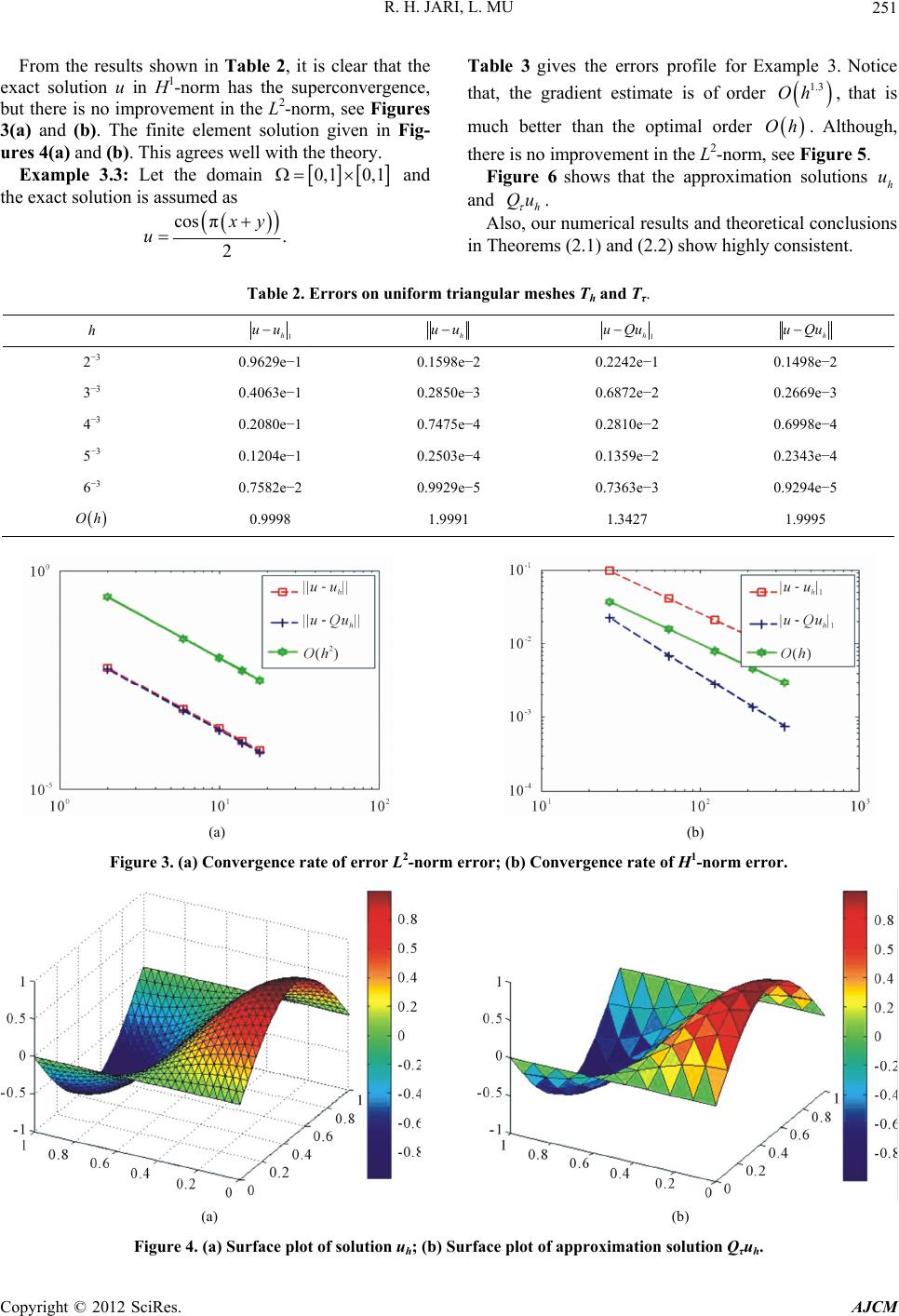 R. H. JARI, L. MU 251 From the results shown in Table 2, it is clear that the exact solution u in H1-norm has the superconvergence, but there is no improvement in the L2-norm, see Figures 3(a) and (b). The finite element solution given in Fig- ures 4(a) and (b). This agrees well with the theory. Example 3.3: Let the domain 0,1 0,1 and the exact solution is assumed as cos π . 2 y u Table 3 gives the errors profile for Example 3. Notice that, the gradient estimate is of order , that is 1.3 Oh much better than the optimal order . Although, there is no improvement in the L2-norm, see Figure 5. Oh Figure 6 shows that the approximation solutions and . h u h Also, our numerical results and theoretical conclusions in Theorems (2.1) and (2.2) show highly consistent. Qu Table 2. Errors on uniform triangular meshes Th and Tτ. h 1 h uu h uu 1 h uQu h uQu 2−3 0.9629e−1 0.1598e−2 0.2242e−1 0.1498e−2 3−3 0.4063e−1 0.2850e−3 0.6872e−2 0.2669e−3 4−3 0.2080e−1 0.7475e−4 0.2810e−2 0.6998e−4 5−3 0.1204e−1 0.2503e−4 0.1359e−2 0.2343e−4 6−3 0.7582e−2 0.9929e−5 0.7363e−3 0.9294e−5 Oh 0.9998 1.9991 1.3427 1.9995 (a) (b) Figure 3. (a) Convergence rate of error L2-norm error; (b) Convergence rate of H1-norm error. (a) (b) Figure 4. (a) Surface plot of solution uh; (b) Surface plot of approximation solution Qτuh. Copyright © 2012 SciRes. AJCM 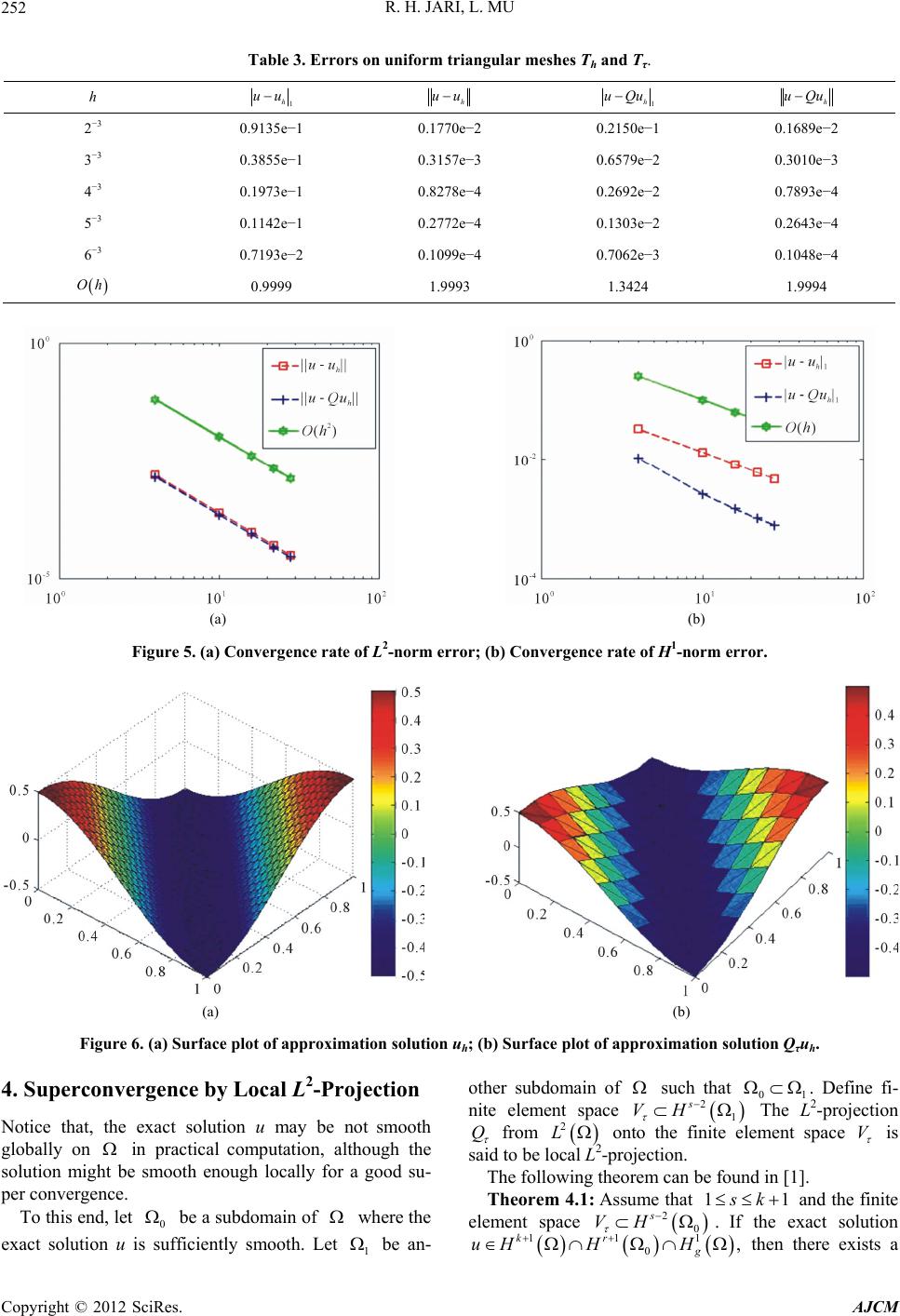 R. H. JARI, L. MU 252 Table 3. Errors on uniform triangular meshes Th and Tτ. h 1 h uu h uu 1 h uQu h uQu 2−3 0.9135e−1 0.1770e−2 0.2150e−1 0.1689e−2 3−3 0.3855e−1 0.3157e−3 0.6579e−2 0.3010e−3 4−3 0.1973e−1 0.8278e−4 0.2692e−2 0.7893e−4 5−3 0.1142e−1 0.2772e−4 0.1303e−2 0.2643e−4 6−3 0.7193e−2 0.1099e−4 0.7062e−3 0.1048e−4 Oh 0.9999 1.9993 1.3424 1.9994 (a) (b) Figure 5. (a) Convergence rate of L2-norm error; (b) Convergence rate of H1-norm error. (a) (b) Figure 6. (a) Surface plot of approximation solution uh; (b) Surface plot of approximation solution Qτuh. 4. Superconvergence by Local L2-Projection Notice that, the exact solution u may be not smooth globally on in practical computation, although the solution might be smooth enough locally for a good su- per convergence. To this end, let be a subdomain of where the 0 exact solution u is sufficiently smooth. Let be an- 1 other subdomain of such that 01 . Define fi- nite element space The L2-projection 2 1 s VH Q from 2 L onto the finite element space V is said to be local L2-projection. The following theorem can be found in [1]. Theorem 4.1: Assume that 11 k and the finite element space 2 0 s VH . If the exact solution 11 0 kr H H 1 , g uH then there exists a Copyright © 2012 SciRes. AJCM 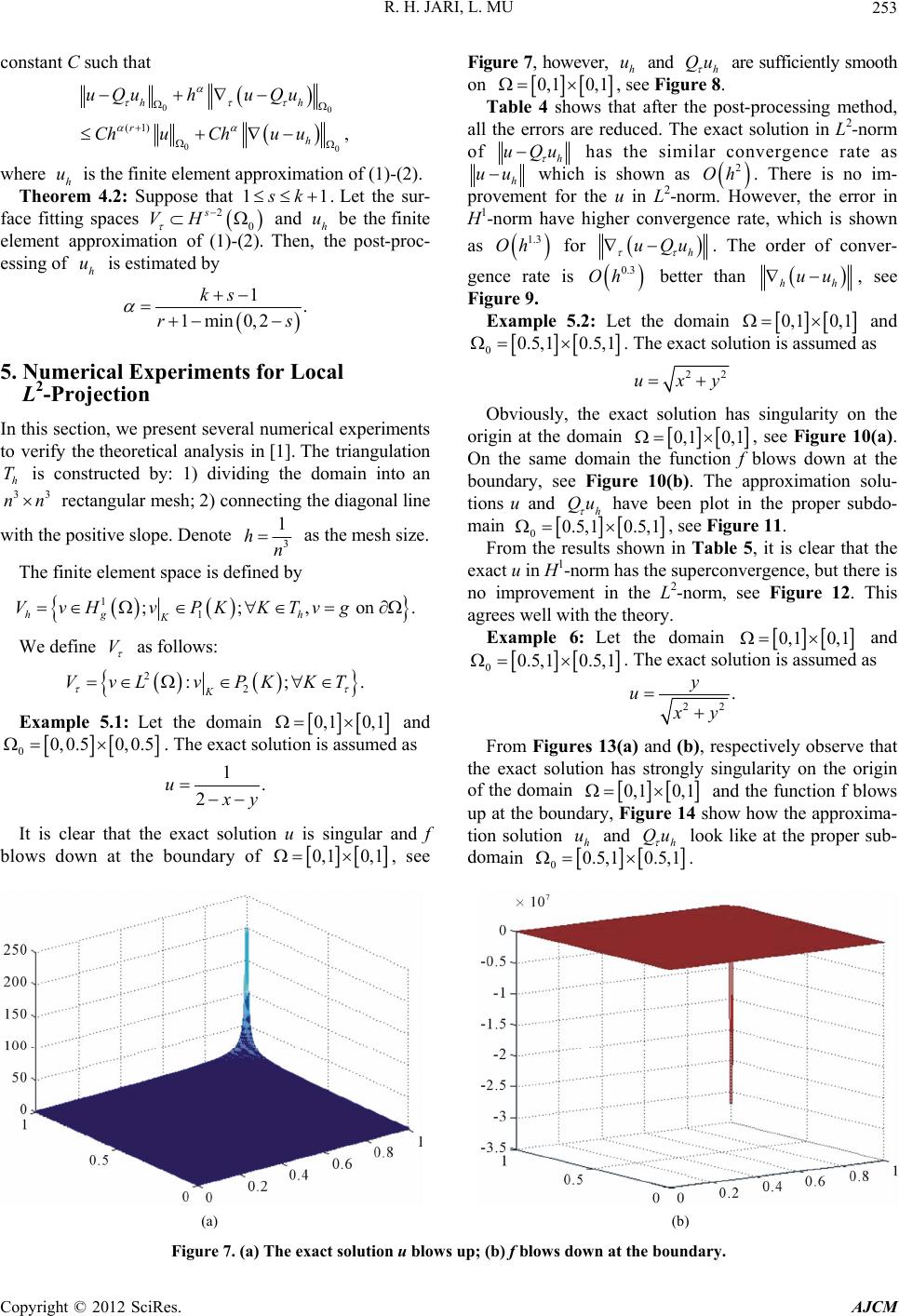 R. H. JARI, L. MU 253 constant C such that 00 00 (1) , hh rh uQu huQu ChuChu u where is the finite element approximation of (1)-(2). h Theorem 4.2: Suppose that 1 u 1 k. Let the sur- face fitting spaces 0 u 2s VH and h be the finite element approximation of (1)-(2). Then, the post-proc- essing of is estimated by h u 1. 1min0,2 ks rs 5. Numerical Experiments for Local L2-Projection In this section, we present several numerical experiments to verify the theoretical analysis in [1]. The triangulation is constructed by: 1) dividing the domain into an h T 3 nn3 rectangular mesh; 2) connecting the diagonal line with the positive slope. Denote 3 1 hn as the mesh size. The finite element space is defined by 1 1 ;;, on . hg h K VvH vPKKTvg We define V as follows: 2 2 :; K VvL vPKKT . Example 5.1: Let the domain 0,1 0,1 and 00, 0.50, 0.5 . The exact solution is assumed as 1. 2 u y It is clear that the exact solution u is singular and f blows down at the boundary of 0,1 0,1 , see Figure 7, however, h and h Qu are sufficiently smooth on u 0,1 0,1 , see Figure 8. Table 4 shows that after the post-processing method, all the errors are reduced. The exact solution in L2-norm of h uQu has the similar convergence rate as h uu which is shown as . There is no im- provement for the u in L2-norm. However, the error in H1-norm have higher convergence rate, which is shown 2 Oh as 1.3 Oh for h uQu . The order of conver- gence rate is 0.3 Oh better than hh uu, see Figure 9. Example 5.2: Let the domain 0,1 0,1 and 00.5,1 0.5,1 . The exact solution is assumed as 22 uxy Obviously, the exact solution has singularity on the origin at the domain 0,1 0,1 , see Figure 10(a). On the same domain the function f blows down at the boundary, see Figure 10(b). The approximation solu- tions u and have been plot in the proper subdo- main h Qu 0 From the results shown in Table 5, it is clear that the exact u in H1-norm has the superconvergence, but there is no improvement in the L2-norm, see Figure 12. This agrees well with the theory. 0.5,1 0.5,1 , see Figure 11. Example 6: Let the domain 0,1 0,1 and 00.5,1 0.5,1 . The exact solution is assumed as 22 . y u y From Figures 13(a) and (b), respectively observe that the exact solution has strongly singularity on the origin of the domain 0,1 0,1 h uh Qu and the function f blows up at the boundary, Figure 14 show how the approxima- tion solution and look like at the proper sub- domain 0 0.5,1 0.5,1. (a) (b) Figure 7. (a) The exact solution u blows up; (b) f blows down at the boundary. Copyright © 2012 SciRes. AJCM 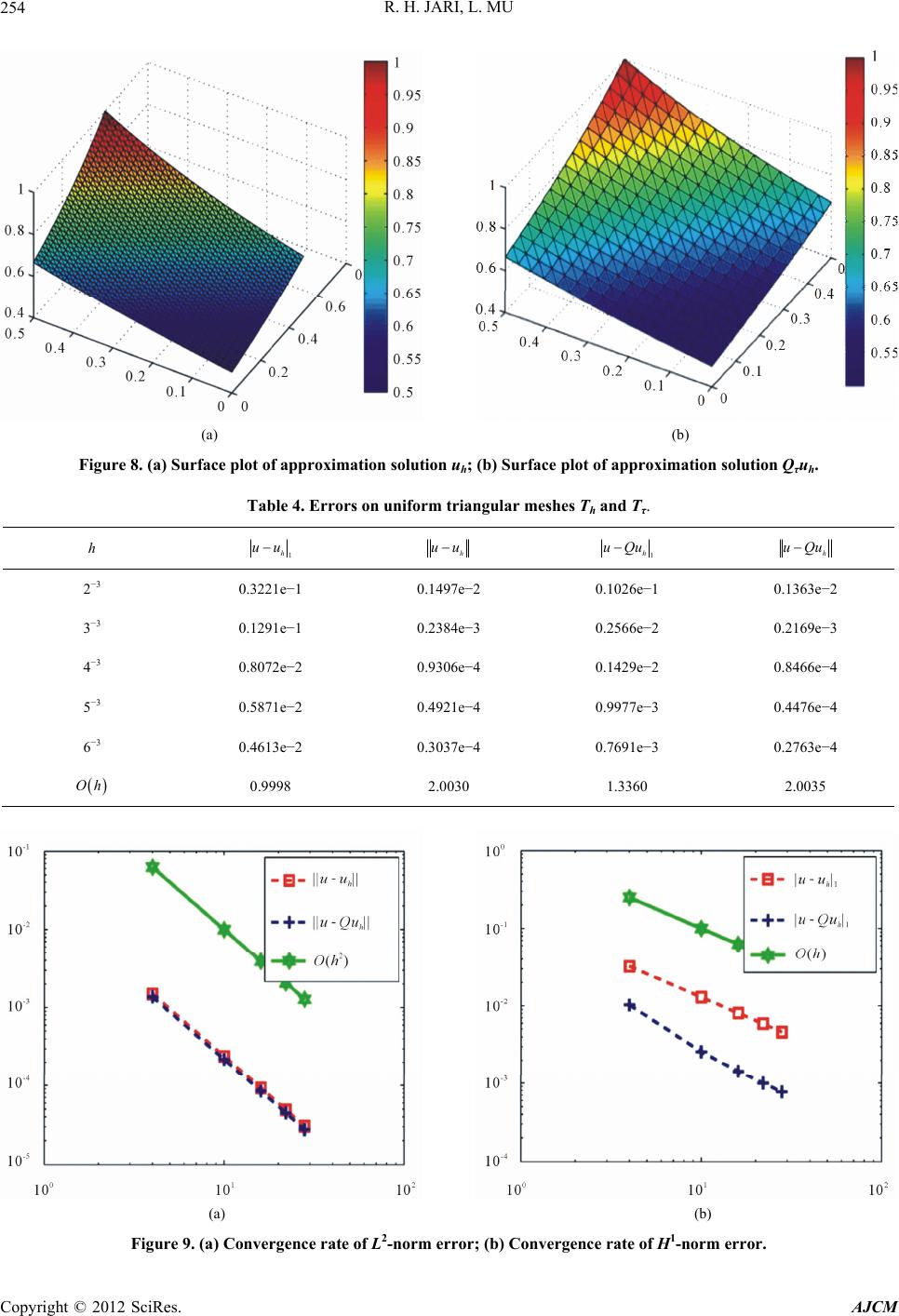 R. H. JARI, L. MU 254 (a) (b) Figure 8. (a) Surface plot of approximation solution uh; (b) Surface plot of approximation solution Qτuh. Table 4. Errors on uniform triangular meshes Th and Tτ. h 1 h uu h uu 1 h uQu h uQu 2−3 0.3221e−1 0.1497e−2 0.1026e−1 0.1363e−2 3−3 0.1291e−1 0.2384e−3 0.2566e−2 0.2169e−3 4−3 0.8072e−2 0.9306e−4 0.1429e−2 0.8466e−4 5−3 0.5871e−2 0.4921e−4 0.9977e−3 0.4476e−4 6−3 0.4613e−2 0.3037e−4 0.7691e−3 0.2763e−4 Oh 0.9998 2.0030 1.3360 2.0035 (a) (b) Figure 9. (a) Convergence rate of L2-norm error; (b) Convergence rate of H1-norm error. Copyright © 2012 SciRes. AJCM  R. H. JARI, L. MU 255 (a) (b) Figure 10. (a) Surface plot of exact solution u; (b) f blows down at the boundary. (a) (b) Figure 11. (a) Surface plot of approximation solution uh; (b) Surface plot of approximation solution Qτuh. Table 5. Errors on uniform triangular meshes Th and Tτ. h 1 h uu h uu 1 h uQu h uQu 2−3 0.1352e−1 0.1400e−2 0.6141e−2 0.1287e−2 3−3 0.6835e−2 0.3596e−3 0.2110e−2 0.3314e−3 4−3 0.4566e−2 0.1607e−3 0.1215e−2 0.1481e−3 5−3 0.3427e−2 0.9058e−4 0.8529e−3 0.8352e−4 6−3 0.2743e−2 0.5802e−4 0.6590e−3 0.5350e−4 Oh 0.9923 1.9806 1.3581 1.9792 Copyright © 2012 SciRes. AJCM 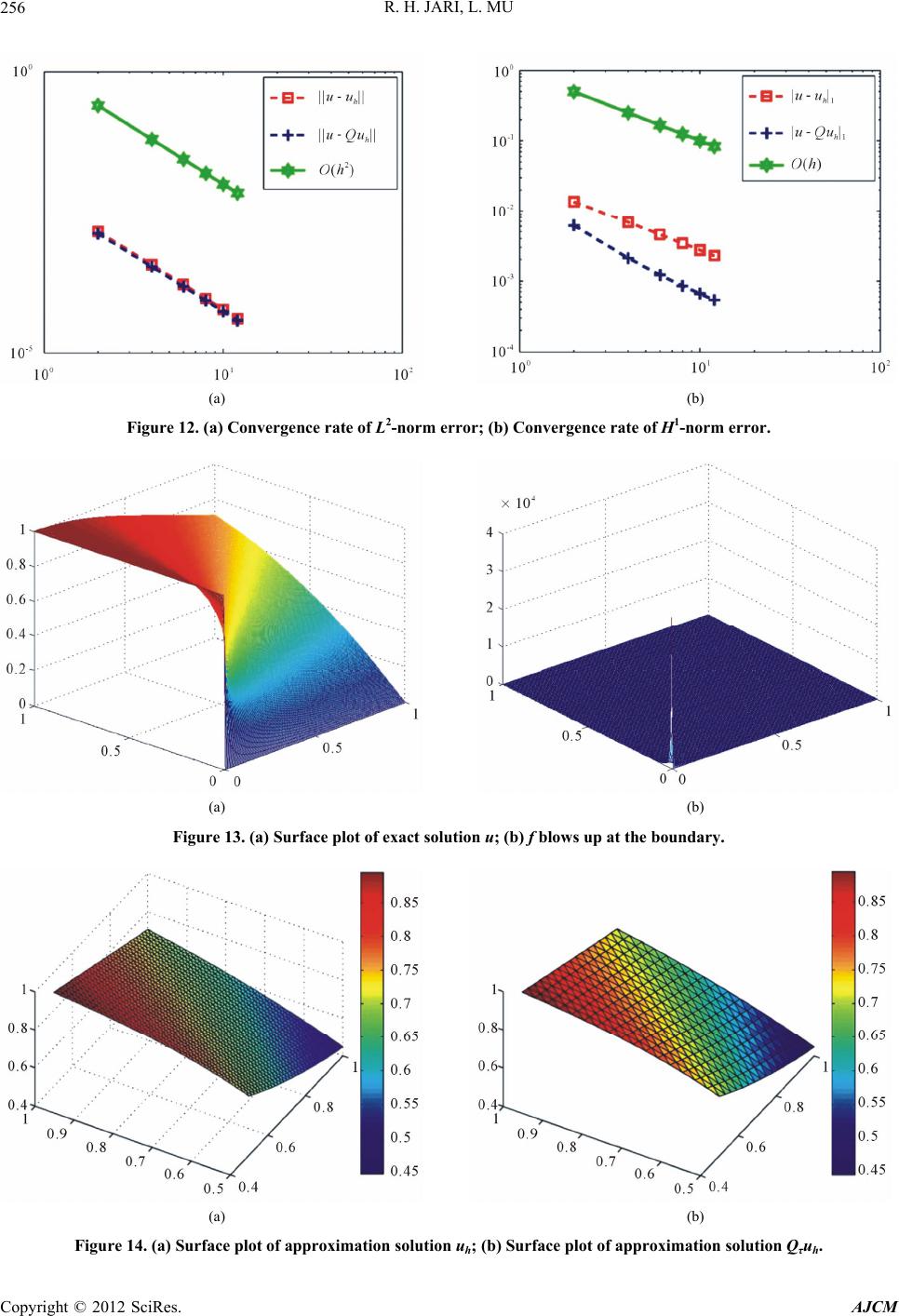 R. H. JARI, L. MU 256 (a) (b) Figure 12. (a) Convergence rate of L2-norm error; (b) Convergence rate of H1-norm error. (a) (b) Figure 13. (a) Surface plot of exact solution u; (b) f blows up at the boundary . (a) (b) Figure 14. (a) Surface plot of approximation solution uh; (b) Surface plot of approximation solution Qτuh. Copyright © 2012 SciRes. AJCM 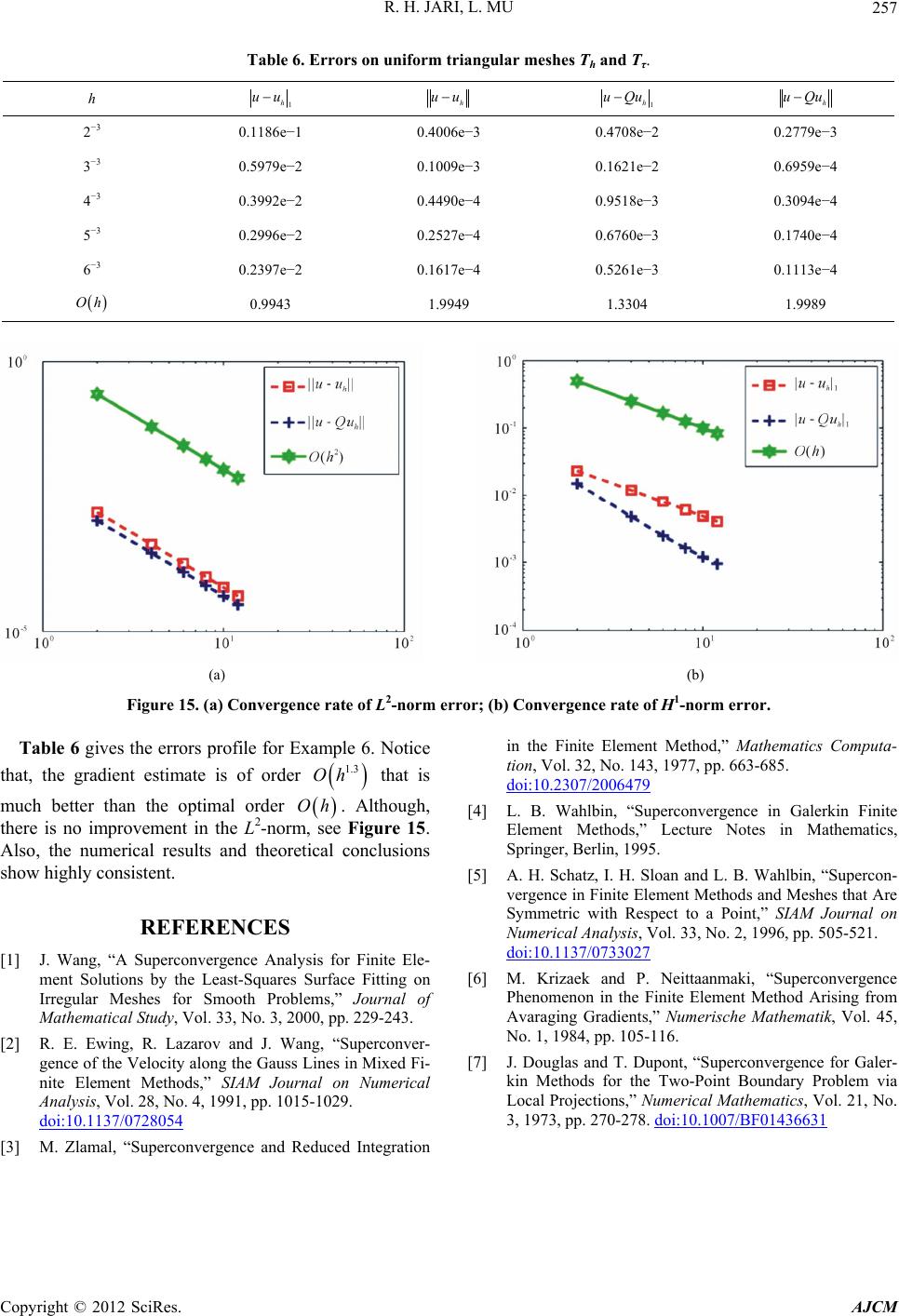 R. H. JARI, L. MU Copyright © 2012 SciRes. AJCM 257 Table 6. Errors on uniform triangular meshes Th and Tτ. h 1 h uu h uu 1 h uQu h uQu 2−3 0.1186e−1 0.4006e−3 0.4708e−2 0.2779e−3 3−3 0.5979e−2 0.1009e−3 0.1621e−2 0.6959e−4 4−3 0.3992e−2 0.4490e−4 0.9518e−3 0.3094e−4 5−3 0.2996e−2 0.2527e−4 0.6760e−3 0.1740e−4 6−3 0.2397e−2 0.1617e−4 0.5261e−3 0.1113e−4 Oh 0.9943 1.9949 1.3304 1.9989 (a) (b) Figure 15. (a) Convergence rate of L2-norm error; (b) Convergence rate of H1-norm error. Table 6 gives the errors profile for Example 6. Notice that, the gradient estimate is of order that is 1.3 Oh much better than the optimal order . Although, there is no improvement in the L2-norm, see Figure 15. Also, the numerical results and theoretical conclusions show highly consistent. Oh REFERENCES [1] J. Wang, “A Superconvergence Analysis for Finite Ele- ment Solutions by the Least-Squares Surface Fitting on Irregular Meshes for Smooth Problems,” Journal of Mathematical Study, Vol. 33, No. 3, 2000, pp. 229-243. [2] R. E. Ewing, R. Lazarov and J. Wang, “Superconver- gence of the Velocity along the Gauss Lines in Mixed Fi- nite Element Methods,” SIAM Journal on Numerical Analysis, Vol. 28, No. 4, 1991, pp. 1015-1029. doi:10.1137/0728054 [3] M. Zlamal, “Superconvergence and Reduced Integration in the Finite Element Method,” Mathematics Computa- tion, Vol. 32, No. 143, 1977, pp. 663-685. doi:10.2307/2006479 [4] L. B. Wahlbin, “Superconvergence in Galerkin Finite Element Methods,” Lecture Notes in Mathematics, Springer, Berlin, 1995. [5] A. H. Schatz, I. H. Sloan and L. B. Wahlbin, “Supercon- vergence in Finite Element Methods and Meshes that Are Symmetric with Respect to a Point,” SIAM Journal on Numerical Analysis, Vol. 33, No. 2, 1996, pp. 505-521. doi:10.1137/0733027 [6] M. Krizaek and P. Neittaanmaki, “Superconvergence Phenomenon in the Finite Element Method Arising from Avaraging Gradients,” Numerische Mathematik, Vol. 45, No. 1, 1984, pp. 105-116. [7] J. Douglas and T. Dupont, “Superconvergence for Galer- kin Methods for the Two-Point Boundary Problem via Local Projections,” Numerical Mathematics, Vol. 21, No. 3, 1973, pp. 270-278. doi:10.1007/BF01436631
|